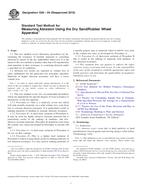Potřebujeme váš souhlas k využití jednotlivých dat, aby se vám mimo jiné mohly ukazovat informace týkající se vašich zájmů. Souhlas udělíte kliknutím na tlačítko „OK“.
ASTM G65-04(2010)
Standard Test Method for Measuring Abrasion Using the Dry Sand/Rubber Wheel Apparatus
Automaticky přeložený název:
Standardní zkušební metoda pro měření proti otěru pomocí přístroje Dry Sand / Rubber kola
NORMA vydána dne 1.12.2010
Informace o normě:
Označení normy: ASTM G65-04(2010)
Poznámka: NEPLATNÁ
Datum vydání normy: 1.12.2010
Kód zboží: NS-57772
Počet stran: 13
Přibližná hmotnost: 39 g (0.09 liber)
Země: Americká technická norma
Kategorie: Technické normy ASTM
Anotace textu normy ASTM G65-04(2010) :
Keywords:
abrasion resistance-metals/metallic materials, dry sand/rubber wheel test, metals and metallic materials, rubber wheel test, resistance of metallic materials to scratching abrasion, by dry, Sand/Rubber Wheel test, ICS Number Code 17.040.20 (Properties of surfaces)
Doplňující informace
| Significance and Use | ||||||||||||||||||
|
The severity of abrasive wear in any system will depend upon the abrasive particle size, shape, and hardness, the magnitude of the stress imposed by the particle, and the frequency of contact of the abrasive particle. In this practice these conditions are standardized to develop a uniform condition of wear which has been referred to as scratching abrasion (1 and 2). The value of the practice lies in predicting the relative ranking of various materials of construction in an abrasive environment. Since the practice does not attempt to duplicate all of the process conditions (abrasive size, shape, pressure, impact, or corrosive elements), it should not be used to predict the exact resistance of a given material in a specific environment. Its value lies in predicting the ranking of materials in a similar relative order of merit as would occur in an abrasive environment. Volume loss data obtained from test materials whose lives are unknown in a specific abrasive environment may, however, be compared with test data obtained from a material whose life is known in the same environment. The comparison will provide a general indication of the worth of the unknown materials if abrasion is the predominant factor causing deterioration of the materials. |
||||||||||||||||||
| 1. Scope | ||||||||||||||||||
|
1.1 This test method covers laboratory procedures for determining the resistance of metallic materials to scratching abrasion by means of the dry sand/rubber wheel test. It is the intent of this test method to produce data that will reproducibly rank materials in their resistance to scratching abrasion under a specified set of conditions. 1.2 Abrasion test results are reported as volume loss in cubic millimetres for the particular test procedure specified. Materials of higher abrasion resistance will have a lower volume loss. Note 1—In order to attain uniformity among laboratories, it is the intent of this test method to require that volume loss due to abrasion be reported only in the metric system as cubic millimetres. 1 mm3 = 6.102 × 10 −5 in3. 1.3 This test method covers five recommended procedures which are appropriate for specific degrees of wear resistance or thicknesses of the test material. 1.3.1 Procedure A—This is a relatively severe test which will rank metallic materials on a wide volume loss scale from low to extreme abrasion resistance. It is particularly useful in ranking materials of medium to extreme abrasion resistance. 1.3.2 Procedure B—A short-term variation of Procedure A. It may be used for highly abrasive resistant materials but is particularly useful in the ranking of medium- and low-abrasive-resistant materials. Procedure B should be used when the volume–loss values developed by Procedure A exceeds 100 mm3. 1.3.3 Procedure C—A short-term variation of Procedure A for use on thin coatings. 1.3.4 Procedure D—This is a lighter load variation of Procedure A which is particularly useful in ranking materials of low-abrasion resistance. It is also used in ranking materials of a specific generic type or materials which would be very close in the volume loss rates as developed by Procedure A. 1.3.5 Procedure E—A short-term variation of Procedure B that is useful in the ranking of materials with medium- or low-abrasion resistance. 1.4 This standard does not purport to address the safety concerns, if any, associated with its use. It is the responsibility of the user of this standard to establish appropriate safety and health practices and determine the applicability of regulatory limitations prior to use. |
||||||||||||||||||
| 2. Referenced Documents | ||||||||||||||||||
|
Odebírejte informace o nově vydaných normách ZDARMA:
Chcete pravidelně odebírat informace o nově vycházejících normách z celého světa a to zcela zdarma?
Přihlašte se k odběru. Vše je velice jednoduché a absolutně ZDARMA.
Na výběr máte vydavatele z celého světa.




 Cookies
Cookies
